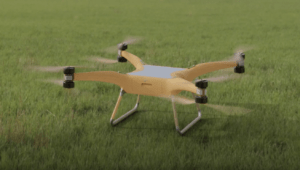UAS-manufacturer Leichtwerk Research GmbH, eco-material-researcher Fraunhofer WKI and adhesives specialist Jowat SE have teamed up for the collaborative development of an innovative new multicopter, dubbed Project HerMes. The model features ultra-light structural designs crafted from renewable lightweight materials such as wood and natural fiber-reinforced plastics.
The majority of multicopters are typically composed of relatively simple configurations made from semi finished products and conventional or fiber-reinforced plastics (FRP). Fiber-reinforced plastics possess deficiencies in structural efficiency, and carry all of the major environmental problems that come with plastics. The production process also involves energy-intensive procedures and makes use of fossil raw materials such as polymers made from propene, as well as critical raw materials like catalysts made from bismuth or platinum. When FRP components are no longer usable, they carry yet another problem in their poor recyclability. As a result of the rapid global economic development of recent decades and the associated problems of environmental degradation, resource exploitation and climate change, it has become more and more critical to create more sustainable products and economic models.

Building a Multicopter of Renewable Materials
“Conventional FRP are virtually overqualified for all those applications in which their high specific strengths and stiffnesses clearly exceed the moderate load requirements, such as for smaller UAS”, said Dr. Martin Pietrek of Leichtwerk Research in Braunschweig Germany. “In the project HerMes we are developing a totally new approach to design and manufacture multicopter airframes, which are not only lighter compared to conventional FRP-frames but also enable reduced energy and resource consumption as well as good recyclability and cost efficiency.”
From its inception, the HerMes multicopter has been under development with a focus on later technical qualification in order to allow for demanding and safety-critical applications, such as flight operations in SORA SAIL III/IV. Such an approach results in a highly complex development process. Aside from the aeronautical development of the aircraft, the process also involves the development of advanced structural materials, new adhesive systems and surface protection agents based on renewable raw materials.






